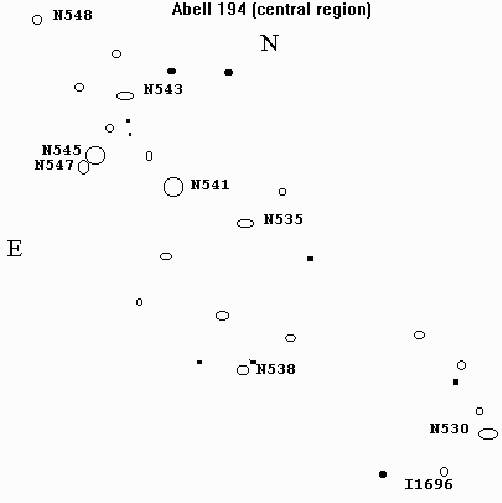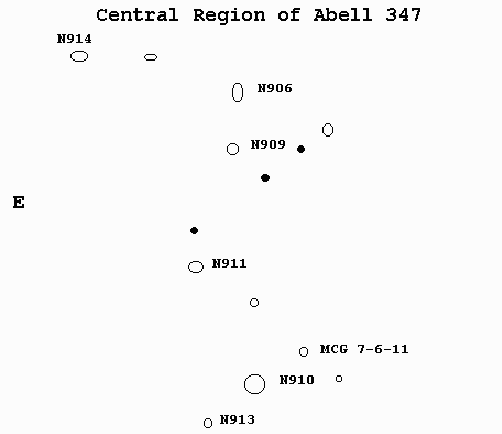Observing Galaxy Clusters
Michael Purcell
For me, it began during our April 1996 visit to New Mexico. It was about 2:00 A.M. Rich Burns came over and asked if I could confirm the image he had in his 12.5 inch Dobsonian. When he mentioned that it was a galaxy cluster, I was intrigued and immediately agreed. A couple of faint galaxies were readily apparent, and more were visible with averted vision. I went back to my scope and took a CCD picture of the cluster, Abell 2065, shown below. Note that I have blackened out the stars in the image, leaving just the galaxies.
The only Abell cluster specifically identified in the Uranometria 2000, 2065 is found on chart #154. The Uranometria Deep Sky Field Guide describes it as "Not usually visible in amateur telescopes." This is not surprising given that the "brightest" galaxy in the field is a dim magnitude 15.5! The rest are magnitude 16 or fainter. Several factors combined to make the galaxies visible to us: a fast Dobsonian, exceptional seeing, and an object located at the zenith.
More recently, several members of my family and I had the good fortune to be vacationing in New Mexico at the Star Hill Inn. We had been using their Celestron Compustar 14" SCT to successfully find and observe a wide variety of objects. It occurred to me to see if any Abell clusters were visible. A review of the Webb Society DSO Handbook #5 (Clusters of Galaxies) turned up several clusters that would be overhead that week. It also included finder charts, lists of all cluster objects, and hand sketches of various eyepiece views by other observers. This was exactly what we needed to hunt down these very distant, very dim objects.
The clusters we observed are described below. We viewed them first with the Compustar 14. Later in the week we revisited them with the Star Hill Inn 22" Dobsonian (star-hopping all the way - Jack Kramer would approve!). The associated charts are based on drawings from the Webb handbook. These are simplified versions. All charts are about 1/2 degree square - close to what you might see in a wide field eyepiece. I encourage you to use the actual handbook if possible.
Abell 194 (U2000 chart #218, see NGC 541; Webb handbook pg. 103): This cluster fills an area almost 2 degrees square. In its central region we were able to identify NGC 541, NGC 543, and NGC 545/7. These galaxies form a triangle that acts as a good reference for the other objects around it. Also, NGC 538, NGC 535, NGC 530, IC 1696, and MGC objects 0-4-139 and 0-4-129 were all visible along with several other objects for which the Webb handbook had no specific designations. Our success with this cluster encouraged us to try for the others.

Abell 262 (U2000 chart #92, see NGC 708 etc.; Webb handbook pg. 111): This cluster is described in the Webb handbook as a condensation in a supercluster that stretches over 10 degrees from (1h 54m, +36o 00') in southern Andromeda to (1h 8m, +32 o 30') in northern Pisces. NGC 703/4/5/8 form a "Y" shaped fuzzy blob in the center, very similar to Stephan's Quintet. NGC 714 and 718 are the most readily visible in the group.
Abell 347 (U2000 chart #62, see NGC 910 etc.; Webb handbook pg. 119): Located near NGC 891, this cluster is not too difficult to find. Its only disadvantage is being fairly dispersed across the sky.

Abell 426 (U2000 chart # 63, see NGC 1275 "Perseus A"; Webb handbook pg. 123): My first impression of this cluster was of extremely faint rabbit tracks running diagonally across the field of view. NGC 1275 and 1272 were immediately apparent. The rest tended to require averted vision. Later that night, working on my notes, I suddenly realized that I already had a picture of the cluster! I had taken it from my driveway in November 1995. I had merely been trying to capture the center of Perseus cluster, only later realizing that I had luckily included Perseus A in the image.
In the image below, I have removed as many stars as I could, and flipped the image to correspond to the Webb handbook diagram. The bright galaxy at bottom center is Perseus A. The edge of NGC 1272 is at the bottom right corner. Unfortunately, this image does not contain enough of the cluster to show the "rabbit tracks". You will have to check it out for yourself!
General comments: The brightest galaxy in these clusters is about magnitude 13, the rest are in the range of 14-16. We noticed that even with averted vision, many of the galaxies tended to appear and disappear as the atmosphere momentarily cleared further. We also discovered that concentrated "staring" with averted vision would fatigue our eyes and cause us to periodically stop seeing the field entirely; sort of a "reciprocity failure" of the eyes! Searching out these objects is fascinating and rewarding (although occasionally frustrating), and I highly recommend it!
(My thanks to Rich Burns for triggering my interest in the visual observation of galaxy clusters. -- MP)
Published in the November 1996 issue of the NightTimes






